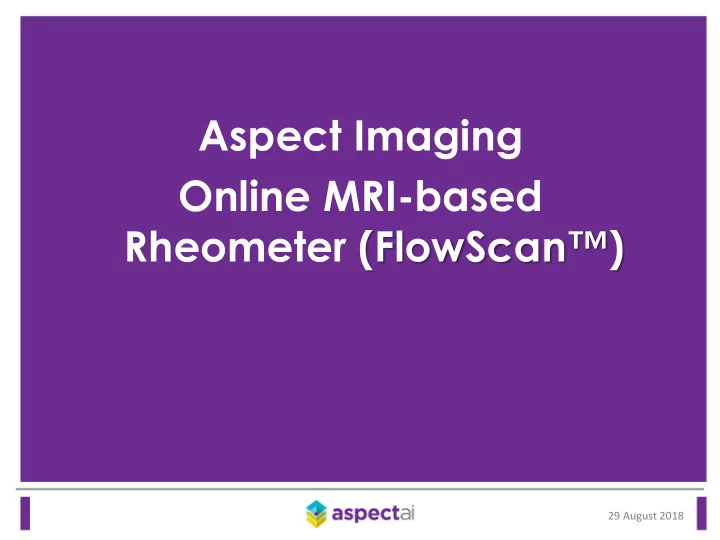

Aspect Imaging Online MRI-based Rheometer (FlowScan ™) 29 August 2018
Based on principles of capillary viscometry Assumptions: • ▪ flow is laminar ▪ flow is steady state ▪ fluid properties are constant ▪ no slip at walls ▪ axial velocity component only 100 10.0 8.0 radial position (mm) 6.0 shear stress (Pa) 4.0 2.0 10 0.0 -2.0 -4.0 -6.0 FLOWSCAN -8.0 -10.0 1 0 0.5 1 1 10 100 1000 shear rate (1/s) velocity (m/s) Velocity FlowScan Rheogram velocity image profile
FlowScan TM System
Viscosity as a function of shear rate Maximum shear rate Radial distance r Zero shear rate z Velocity L Velocity profile Pressure difference SHEAR RATE SHEAR STRESS VISCOSITY ( P ) dV z ( r ) ( r ) r + dr 2 L
Real-Time Rheology of Personal Care Products: Liquid Hand Soap 100 shear stress (Pa) 10 FLOWSCAN ROTATIONAL 1 1 10 100 1000 shear rate (1/s) FlowScan-derived rheogram velocity image
Overview of Rheological Properties of Personal Care Products: 100 Dishwasher Gel MRI Liquid hand soap MRI 10 Laundry Detergent MRI Viscosity (Pa.s) Carbopol 0.1% MRI 1 Xanthan 0.2 % MRI Dishwasher Gel Offline 0.1 Liquid hand soap Offline Laundry Detergent Offline 0.01 Carbopol 0.1% Offline Xanthan 0.2 % Offline 0.001 0.1 1 10 100 1000 Shear Stress (Pa) Online FlowScan (MRI) data vs. offline rheometer
The capability of “seeing” the flow Tozzi et al. Acta mechanica, 224 (10) (2013) Wall slip (6,7) • Settling particles (3,4,5) • Yield stress (6,7) • Turbulence(2) • Early detection of changes in flow conditions 7
Challenges in processing non-Newtonian materials Need to fine-tune quality in real-time • Finding optimum of product • performance vs. cost Need to maximize throughput • Automation of measurement and the • production process A shift towards larger batch sizes • Need for early detection of defects • Minimize wastage and product rejects •
Rheograms in quality and process control: Measurement of product performance Two methods of rheological measurement: 1. OFFLINE MEASUREMENT/ TEST (via conventional rotational rheometer) Versatile (many tests possible) • Slow, laborious • Sample handling issues • Moving parts require maintenance • Issues with particulates •
Rheograms in quality and process control 2 methods of rheological measurement: 1. OFFLINE MEASUREMENT/ TESTS (via conventional rotational rheometer instrumentation) Versatile (many tests possible) • Slow, laborious • Sample handling issues • Moving parts require maintenance • Issues with particulates • 2. REAL-TIME, IN-LINE RHEOLOGY (via MRI or M agnetic R esonance I maging) Measures flow curves plus other properties not • detected by conventional instruments Fast (real-time) • Automated, non-invasive, maintenance-free • Avoids issues of particulates (gap-effect and settling) •
FlowScan ™ Real-time non-intrusive liquid measurement platform : Rheology applied to oil-based drilling muds M i c h a e l M c C a r t h y
FlowScan™: Real Time Drilling Fluids Rheology Inline MRI Rheometry Data is Important Rheology Data • Real Time Hydraulics Modeling • Plastic Viscosity & Yield Point Determination • Hole Cleaning Efficiency • Dilution Economics • Annular Flow Dynamics • Pressure Loss Calculations • Surge & Swab Calculations • 12
Challenges for Measurement of Drilling Muds Inline MRI Rheometry Fluid is extremely challenging • o Multiphase, multicomponent, opaque fluid o Often with large suspended solids Available instruments are not adequate • Utilize small gaps that plug regularly o Require an operator, can be slow o Off-line techniques measure only o small amounts of mud and can easily lead to sampling errors 13
Inline MRI Rheometry How does FlowScan™ Overcome these Challenges? No obstructions to flow • the entire pipe cross section is open Many gallons of material analyzed for each flow curve • minimize sampling errors, high data integrity Measurement is automated and runs continuously • Updated about every 5 minutes Multi-parameter measurements from a single instrument • 14
Newtonian Fluid Results Glycerol 35C 180 160 6.4 [Liter/min] 140 14.3 Shear Stress (Pa) 22.1 120 28.3 100 80 60 40 Circles are data from rotational rheometry Anton Paar AR-100 20 0 500 1000 1500 Shear rate (1/s)
Non-Newtonian Fluid : Carbopol 0.2% Carbopol @ PH=7 50 2.9 [Liter/min] 5.9 8.9 40 10.4 Shear stress [Pa] 14.85 30 Circles are data from off-line rotational rheometer 20 10 0 200 400 600 800 1000 1200 Shear rate [1/s]
Drilling Mud 20 18 16 shear stress [Pa] 14 12 10 1.9 [Liter/min] 2.9 8 5 7.4 8.8 6 11.7 FANN 35 4 FANN 35 after 10 min rest FANN 35 after 30 min rest 2 0 100 200 300 400 500 600 700 800 900 1000 1100 shear rate [1/s]
MRI Advantages (traditional rheometer cannot achieve the following) • Directly measures flow field no assumptions required • Speed of data acquisition • Same instrument from laboratory to process line • Capable of additional measurements including ▪ Composition ▪ Droplet size distribution ▪ Uniformity (degree of mixing)
Thank You Contact Michael McCarthy or Andrew Lonergan for more information: mmccarthy@aspectimaging.com M: +1 530 219 9941 alonergan@aspectimaging.com M: +44 7432 189533 www.aspect-ai.com
Recommend
More recommend